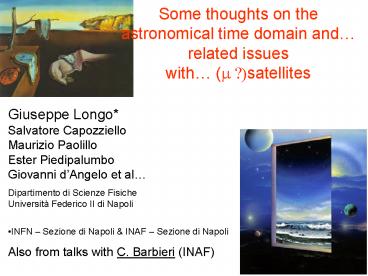Diapositiva 1 - PowerPoint PPT Presentation
Title:
Diapositiva 1
Description:
INFN Sezione di Napoli & INAF Sezione di Napoli. Also from talks with C. ... Finalized OGLE, MACHO, SLOTT-AGAPE (optical) Solar system patrols (optical) ... – PowerPoint PPT presentation
Number of Views:34
Avg rating:3.0/5.0
Title: Diapositiva 1
1
Some thoughts on the astronomical time domain
and related issues with (m ?)satellites
- Giuseppe LongoSalvatore CapozzielloMaurizio
PaolilloEster PiedipalumboGiovanni dAngelo et
al - Dipartimento di Scienze Fisiche Università
Federico II di Napoli - INFN Sezione di Napoli INAF Sezione di
Napoli - Also from talks with C. Barbieri (INAF)
2
What makes un(less)expensive a satellite
No steering (no pointing capabilities) Small
weight and size (hence Small field of
view) Limited scope (non multi-purpose) Must
require little amount of technological
development
3
Astronomical parameter space
Flux
Non-EM
Morphology / Surf.Br.
Time
Wavelength
?
Polarization
Proper motion
Dec
RA
What is the coverage? Where are the gaps? Where
do we go next? Why are space observations needed?
( G.S. Djorgovski Caltech)
4
Parameters defining the TIME DOMAIN at a given l
- Time coverage Tcov(start/end of observations
- Sampling (Dt)(average interval between two
subsequent observations - Integration (Tint)exposure time of typical data
taking
Defines aliasing (maximum lenght of detectable
variations)
Defines sparseness of events and accuracy of
period reconstruction
Defines minimum time scale of events
5
TYPES OF DATA A SIMPLE VIEW
Large f.o.v Surveys
6
Time domain is big business in the
optical Whole sky POSS I II, SDSS, UKIRT,
etc. (optical, NIR, Palomar QUEST and
Palomar NEAT LSST (USA) Finalized OGLE,
MACHO, SLOTT-AGAPE (optical) Solar system
patrols (optical) Supernovae searches
(optical) GRB monitoring (optical and
other) AGN monitoring (radio, little optical)
limited wavelenght coverage fairly deep poor and
uneven sampling long time baseline (months/years)
7
What do you find in surveys? (months to hours
time scales INAF domain)
- Mainly serendipitous discovery of new phenomena
- Better understanding of old phenomena(SN,
distance scale, deceleration, etc.) - Statistically significant samples (NEAR,
asteroids, Kuiper belt, etc up to clusters) - Better characterization of some physical
parameters - Might lead to some exciting new physics (cf.
Amendola) but
8
- What do you find in pointed observations?(months
to hours time scales INAF domain) - Monitoring campaigns lead to variability (from
short to long term) studies for selected objects - Possible periodic behaviors
- Correlations among variations at different
wavelenghts
Periodic light curve of Blazar (binary black
hole) Ciaramella et al. 2004
9
INAF domain
INFN domain
10
The seconds to milliseconds domain
Kilohertz quasiperiodic oscillations in Sco X-1,
(Miller, Strohmayer, Zhang van der Klis,
RXTE)
11
milliseconds to m-seconds
- Tidally-driven transport in accretion disks in
close binary systems (J. M. Blondin,
Hydrodynamics on supercomputers Interacting
Binary Stars) - Photon Bubble Oscillations in Accretion, Klein,
Arons, Jernigan Hsu ApJ 457, L85 (1996)GRO
J1744228 presents quasi-periodic oscillations
(QPOs) of intensities in the energy band 312 keV - Non radial oscillations in neutron stars, Mc
Dermott, Van Horn Hansen, ApJ 325, 725
(1988) - Fluctuations of Pulsar Emission with
Sub-Microsecond Time-Scales, J. Gil, ApSS 110,
293 (1985) - etc
12
The nanoseconds domain
- Nanosecond radio bursts from strong plasma
turbulence in the Crab pulsar, Hankins, Kern,
Weatherhill Eilek, Nature 422, 141 (2003)
13
Nanoseconds astrophysics is already ongoing
within INFN
14
A POSSIBLE EXPERIMENT (which could be possibly
done with a very low cost satellite using
existing INFN/INAF know-how)
Measuring the time delay of multiple QSO images
with second accuracy
15
Quasars time delay from multiple images
T depends on cosmology F depends on the lens
mass model
- Additional benefits
- Detailed structure and mass model of the lens
through microturbulence - High spatial resolution study of the QSO structure
16
Why are X-rays important ?
17
- In the assumption that we can measure
polarization of individual photons - There are mechanisms which entangle photons (ask
Capozziello ) but also on non entangled photons
works with slightly lower accuracy using light
curve shapes
- Angular resolution is not an issue !
(overlapping sequences present a trivial problem
of crittography) - Contamination from non entangled photons may be
tackled (simulations are needed)

